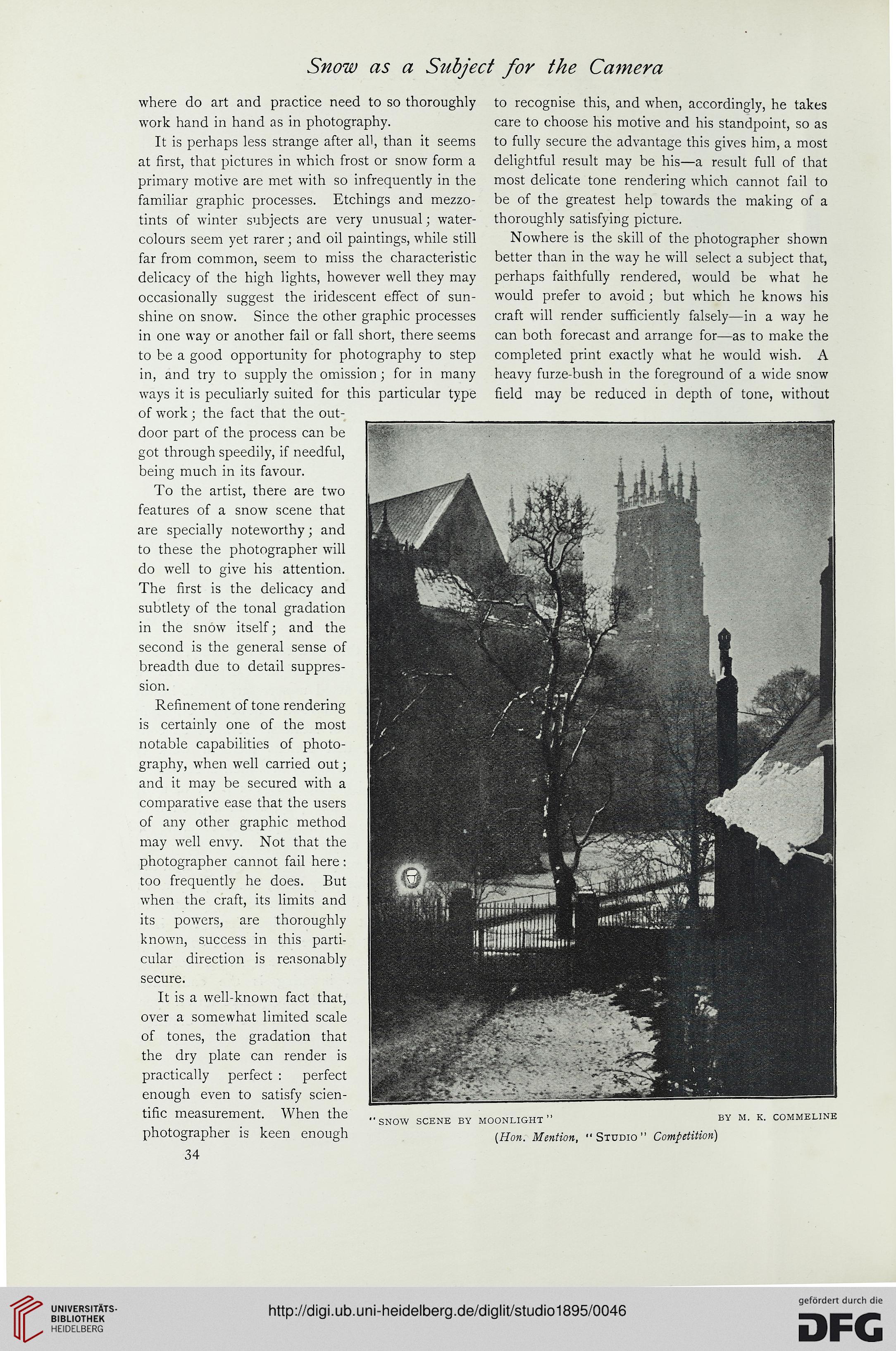Snow as a Subject for the Camera
where do art and practice need to so thoroughly to recognise this, and when, accordingly, he takes
wrork hand in hand as in photography. care to choose his motive and his standpoint, so as
It is perhaps less strange after all, than it seems to fully secure the advantage this gives him, a most
at first, that pictures in which frost or snow form a delightful result may be his—a result full of that
primary motive are met with so infrequently in the most delicate tone rendering which cannot fail to
familiar graphic processes. Etchings and mezzo- be of the greatest help towards the making of a
tints of winter subjects are very unusual; water- thoroughly satisfying picture.
colours seem yet rarer ■ and oil paintings, while still Nowhere is the skill of the photographer shown
far from common, seem to miss the characteristic better than in the way he will select a subject that,
delicacy of the high lights, however well they may perhaps faithfully rendered, would be what he
occasionally suggest the iridescent effect of sun- would prefer to avoid ; but which he knows his
shine on snow. Since the other graphic processes craft will render sufficiently falsely—in a way he
in one way or another fail or fall short, there seems can both forecast and arrange for—as to make the
to be a good opportunity for photography to step completed print exactly what he would wish. A
in, and try to supply the omission ; for in many heavy furze-bush in the foreground of a wide snow
ways it is peculiarly suited for this particular type field may be reduced in depth of tone, without
of work; the fact that the out-
door part of the process can be
got through speedily, if needful,
being much in its favour.
To the artist, there are two
features of a snow scene that
are specially noteworthy; and
to these the photographer will
do well to give his attention.
The first is the delicacy and
subtlety of the tonal gradation
in the snow itself; and the
second is the general sense of
breadth due to detail suppres-
sion.
Refinement of tone rendering
is certainly one of the most
notable capabilities of photo-
graphy, when well carried out •
and it may be secured with a
comparative ease that the users
of any other graphic method
may well envy. Not that the
photographer cannot fail here;
too frequently he does. But
when the craft, its limits and
its powers, are thoroughly
known, success in this parti-
cular direction is reasonably
secure.
It is a well-known fact that,
over a somewhat limited scale
of tones, the gradation that
the dry plate can render is
practically perfect : perfect
enough even to satisfy scien-
tific measurement. When the ..snqw SC£NE by moonlight» by m. k. commeline
photographer is keen enough (#0Mr Mention, " Studio" Competition)
34
where do art and practice need to so thoroughly to recognise this, and when, accordingly, he takes
wrork hand in hand as in photography. care to choose his motive and his standpoint, so as
It is perhaps less strange after all, than it seems to fully secure the advantage this gives him, a most
at first, that pictures in which frost or snow form a delightful result may be his—a result full of that
primary motive are met with so infrequently in the most delicate tone rendering which cannot fail to
familiar graphic processes. Etchings and mezzo- be of the greatest help towards the making of a
tints of winter subjects are very unusual; water- thoroughly satisfying picture.
colours seem yet rarer ■ and oil paintings, while still Nowhere is the skill of the photographer shown
far from common, seem to miss the characteristic better than in the way he will select a subject that,
delicacy of the high lights, however well they may perhaps faithfully rendered, would be what he
occasionally suggest the iridescent effect of sun- would prefer to avoid ; but which he knows his
shine on snow. Since the other graphic processes craft will render sufficiently falsely—in a way he
in one way or another fail or fall short, there seems can both forecast and arrange for—as to make the
to be a good opportunity for photography to step completed print exactly what he would wish. A
in, and try to supply the omission ; for in many heavy furze-bush in the foreground of a wide snow
ways it is peculiarly suited for this particular type field may be reduced in depth of tone, without
of work; the fact that the out-
door part of the process can be
got through speedily, if needful,
being much in its favour.
To the artist, there are two
features of a snow scene that
are specially noteworthy; and
to these the photographer will
do well to give his attention.
The first is the delicacy and
subtlety of the tonal gradation
in the snow itself; and the
second is the general sense of
breadth due to detail suppres-
sion.
Refinement of tone rendering
is certainly one of the most
notable capabilities of photo-
graphy, when well carried out •
and it may be secured with a
comparative ease that the users
of any other graphic method
may well envy. Not that the
photographer cannot fail here;
too frequently he does. But
when the craft, its limits and
its powers, are thoroughly
known, success in this parti-
cular direction is reasonably
secure.
It is a well-known fact that,
over a somewhat limited scale
of tones, the gradation that
the dry plate can render is
practically perfect : perfect
enough even to satisfy scien-
tific measurement. When the ..snqw SC£NE by moonlight» by m. k. commeline
photographer is keen enough (#0Mr Mention, " Studio" Competition)
34




